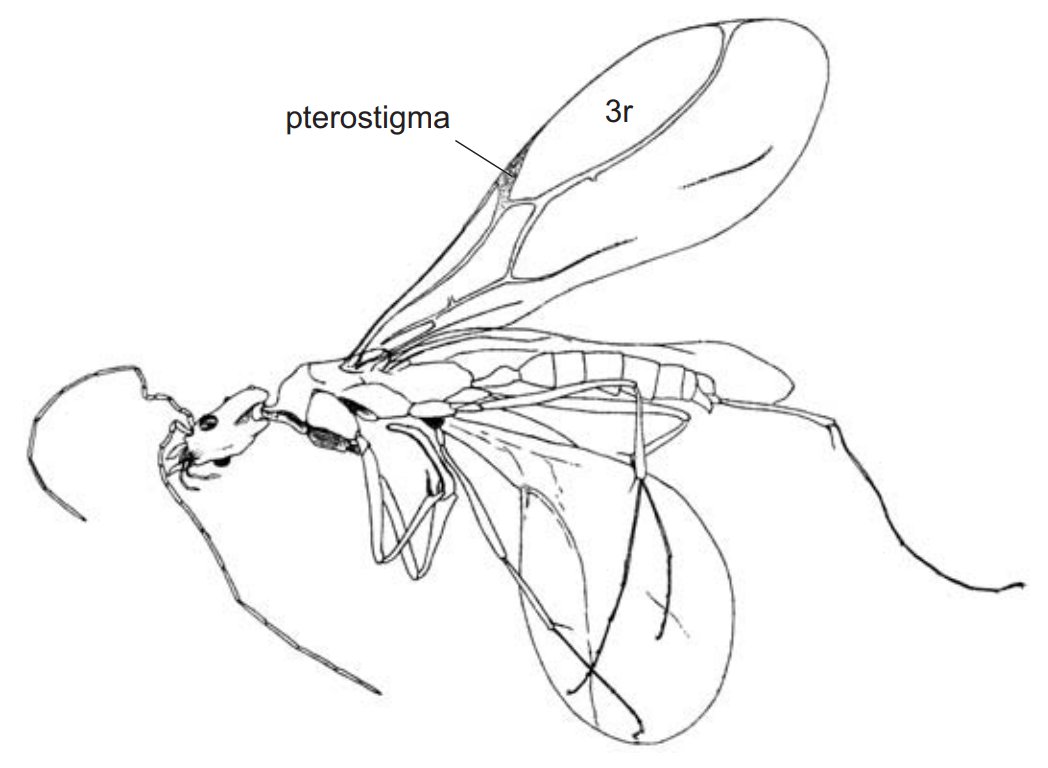Usomyrma on:
[Wikipedia]
[Google]
[Amazon]
''Usomyrma'' is an

extinct
Extinction is the termination of a kind of organism or of a group of kinds (taxon), usually a species. The moment of extinction is generally considered to be the death of the last individual of the species, although the capacity to breed and ...
genus of ant in the formicid subfamily Dolichoderinae. The genus contains a single described species, ''Usomyrma mirabilis'', that is known from two Middle Eocene fossils which were found in Scandinavian amber in Denmark.
History
''Usomyrma mirabilis'' is known from two isolated fossils, the holotype and paratype, both of which were housed in the collections of the University of Copenhagen, Zoological Museum of the University of Copenhagen. The fossils are of two complete adult males which have been preserved as Inclusion (mineral), inclusions in transparent chunks of Scandinavian amber, also known as Danish amber, found in Denmark. Scandinavian amber is thought to be similar in age to Baltic amber, Baltic, Bitterfeld amber, Bitterfeld and Rovno ambers, being approximately late Eocene in age. The four amber faunas have been shown to share 17 ant species in common, which make up over 80% of the specimens in amber collections studied for a 2009 paper. Though a large portion of specimens from Scandinavian amber are of species found in the other ambers, the overall fauna found is notably different from the other three. About twenty-four genera with thirty-five species of ants have been identified as inclusions in Scandinavian amber. The fossils were first studied by paleoentomologists Gennady M. Dlussky of the Moscow State University, Alexander Radchenko of the Polish Academy of Sciences and Dmitry Dubovikoff of the Saint Petersburg State University. Their 2014 Type (biology), type description of the new genus and species was published in the journal ''Acta Palaeontologica Polonica''. They coined the genus name as a combination of the Russian language, Russian ''Us'' meaning "mustache" and often used vernacularly in Russia to mean insect antennae, plus ''myrmecos'' which is Ancient Greek, Greek for "ant". The combination was in recognition of the distinct structuring of the antennae on the males. The specific name (zoology), specific epithet is from the Latin word ''mirabilis'' which translates as "wonderful, marvellous, or miraculous", a nod to the unique morphology of the species.Classification and taxonomy
Based on interpretation of the wing venation in the ''U. mirabilis'', Dlussky ''et al'' suggested the genus was a member of the Dolichoderinae tribe Leptomyrmecini along with the living ''Leptomyrmex'' "spider ants" and the Sicilian amber genus ''Leptomyrmula''. They noted that an unsubscribed male ''Leptomyrmex'' male in Dominican amber was distinct enough from the Dominican amber species ''Leptomyrmex neotropicus'' to possibly warrant being placed into a new genus, but a full description of the male had not taken place as of 2014. Dlussky ''et al'' thought ''U. mirabilis'' represented an ancestral wing venation for the tribe, with a progression in vein reduction being present in ''Leptomyrmula''. The ''Leptomyrmex'' was treated as a descendant genus of the ancestral form ''Usomyrma'' in the classification suggested by Dlussky ''et al''. A 2016 study showed the central cell reduction, on which placement of the genus was based, was shown to be derived several times in the subfamily and not specific to the tribe Leptomyrmecini. The study included the description of the species ''Leptomyrmex relictus'' from Brazil, and study of the micro-''Leptomyrmex'' clade species. While the macro-''Leptomyrmex'' species have a very reduced wing venation, the micro-''Leptomyrmex'' clade is nested inside the macro species but have retained much of the vein structure unlike the macro-species. This mosaic of both retained wing venation and reduced wing venation within ''Leptomyrmex'' contradicted the gradual vein loss hypothesis that was proposed for an evolutionary grade of ''Usomyrma'' - ''Leptomyrmula'' - ''Leptomyrmex''. As such both ''Usomyrma'' and ''Leptomyrmula'' were moved to being placed in Dolichoderinae without tribal placement.
Description
The described males are approximately with a slender profile and elongated appendages. The head is rectangular in outline, being slightly longer than wide, with a straight rear margin and rounded rear edges. Behind the compound eyes, the temples are long with an elevated occiput sporting three large ocelli. Each of the two compound eyes are big, being 0.6 of the head length, with a Reniform stigma, reniform outline, the concave side of the eye along the front sides. The Clypeus (arthropod anatomy), clypeus is distinct in outline, being elongated with the middle swollen to form an almost triangular bump pointing forward and the rear section of the clypeus is retangular and flattened. Each of the Mandible (insect mouthpart), mandibles are triangular and long with a dentate chewing edge that is long and curved showing a pointed apical tooth and at least smaller teeth. Below the crossed mandible tips are the six segmented Insect mouthparts, maxillary palps and the four segmented Insect mouthpart, labial palps. The antennae are elongated with 13 segments, the second funicular segment being distinctly elongate and curved. The fore-wings show a well developed pterostigma and venation that forms several fully closed cells.References
{{Taxonbar, from=Q19636665 Dolichoderinae, † Monotypic fossil ant genera Fossil taxa described in 2014 Eocene insects Fossils of Denmark